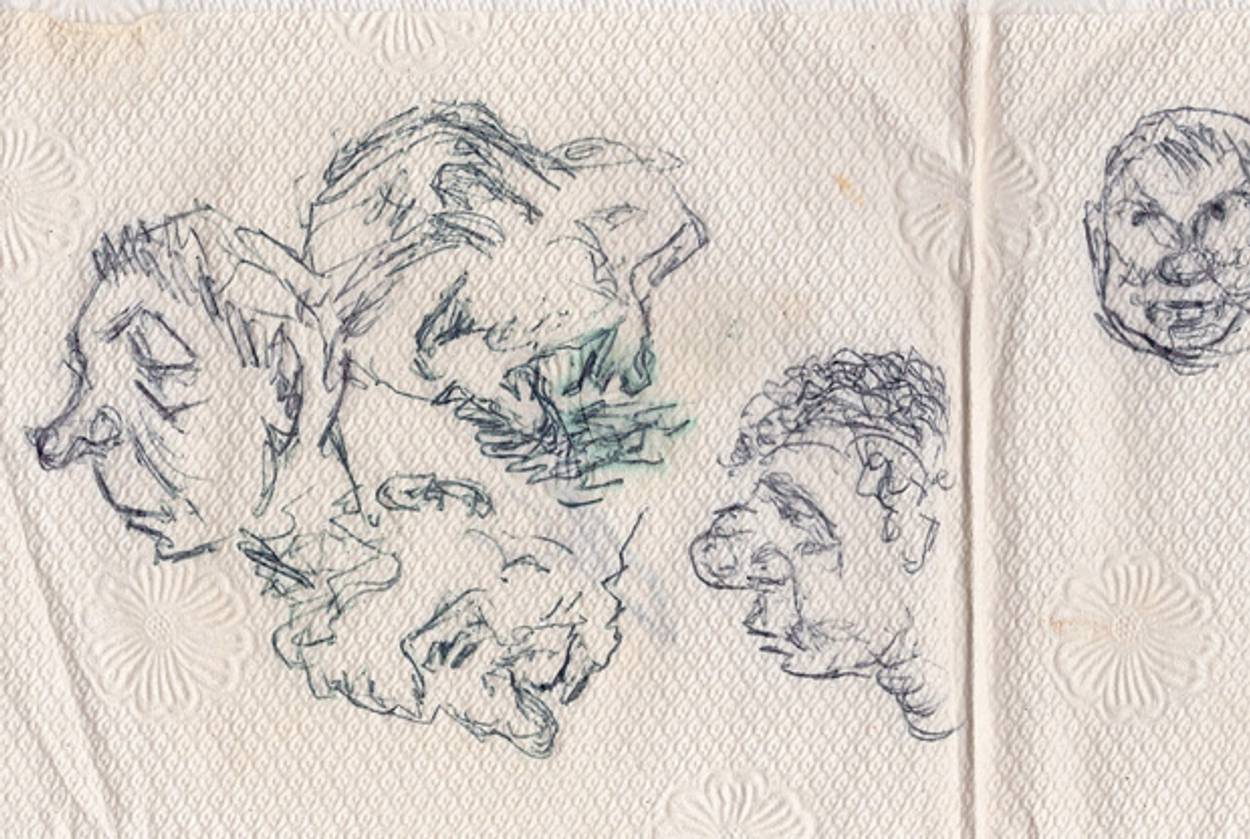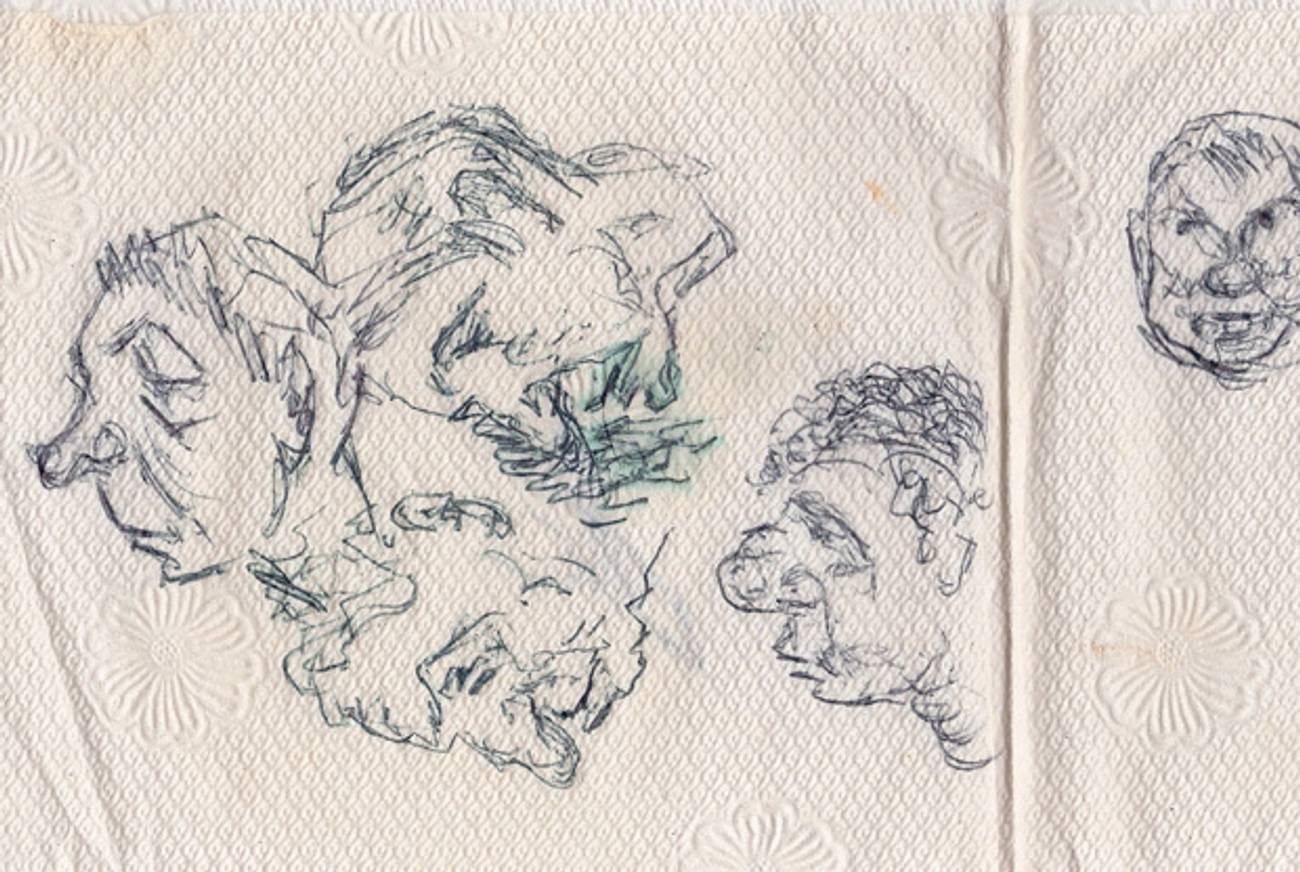The Napkin Artist
Remembering Yiddishist, linguistics scholar, Holocaust survivor, and painter Edward Stankiewicz, who died this year




In April, there was a belated memorial service in the parlor of Pierson College Master’s House for Edward Stankiewicz, linguistics scholar, Yiddishist, painter, and napkin artist. He died on the last day of January after several turbulent years, at 92. A student played the violin and the room slowly filled with a few aging students and loyal friends, a rabbi from Hillel, some elderly Slavicists and mathematicians, his son, and his daughter-in-law. The remembrances made me think of the kind of tribute made by public-school boys honoring a beloved teacher who had flogged them often and hard, for their own good. Stankiewicz was that way. As his son, Steve, explained, “He had no tolerance for what he considered stupidity, which included most people he ever came in contact with.” He was also the most polyglot person I’ve ever encountered—fluent in 14 languages: Polish, Yiddish, German, Russian, Serbo-Croatian, Slovenian, Macedonian, Latin, Italian, French, English, and to a lesser degree Spanish, Bulgarian, and Romanian.
Stankiewicz was a friend, and for a while he and his wife Florence became surrogate grandparents for my children after our family relocated to New Haven from the Chicago area in 1991. He came to many birthdays and Hanukkah parties, gracing us with his elegantly tart turns of phrase and his dashed-off napkin drawings, caricatures of those who sat around our dining-room table. He especially liked subjects who had curly hair and protuberant noses, providing interesting lines for his nimble pen. While Florence was alive, he could still appear stoutly natty; he always wore a suit and tie and had a husky, throaty laugh. I can imagine that in the 1950s, as a young intellectual refugee, he must have been quite debonair.
I quickly learned what he liked: Jewish cooking (latkes), poetry (Mickiewicz), classical music (Carmen). He had learned to play the mandolin when he was a teenager in Warsaw. He loved Polish tangos, and he liked to sing. At a party in the 1980s, Stankiewicz and Victor Erlich together sang the Internationale in Polish. He also took great pride in his contribution to the University of Chicago’s Latke-Hamantash debates:
A Jew develops from the cradle
A craving for a knish and knaydl.
He’ll glorify the gefilte fish,
But I, I love the latke dish.
Long after he retired from Yale’s Slavic Department, he enrolled in local painting classes and went on road trips with his watercolors, capturing picturesque scenes of remote New England villages. He had his favorite restaurants, not formal, but haimish, where the waiters would kibitz in whatever language was on the menu. He reserved his highest praise for those who mastered the fine points of Yiddish, “So-and-so,” he would say, “spoke a beautiful Yiddish.”
He didn’t like: much of what was new (which drove his son and daughter wild); Noam Chomsky, whose concept of the “Language Acquisition Device” he considered beneath contempt; incorrect pronunciation of consonants that ought to be geminated in Italian (though his own pronunciation of English could be hilarious); the wrong-headed notion that Yiddish is a dialect of German. He had been a bystander in the battle of the unfinished Yiddish dictionary, which pitted those who said the aleph should be maintained in words where a syllable ends and the next vowel comes in versus scholars who wanted to eliminate the silent aleph, or schtuma aleph, when it occurs in the middle of a word and use pointilation instead. His tales of more current and personal academic wars could be wearying.
Stankiewicz’s scholarship, hisStudies in Slavic Morphophonemics and Accentology, for instance, was beyond esoteric, but when he was 80 years old he published at last a book that was accessible: My War, Memoir of a Young Jewish Poet. Stankiewicz was a survivor of Warsaw, the Lvov ghetto, Igrenie (a death camp in the Ukraine), and Buchenwald. Up to that point he had said very little to anyone about those experiences—releasing his memories for others to comment upon wasn’t easy. He called it “My War,” of course, because it was his personal experience of the enormity of history, but it was significant that he chose to make it proprietorial and, even then, left out much personal detail. Unlike most Holocaust memoirs, Stankiewicz’s did not begin with family, but rather with school: “I was completing grade school in Warsaw in 1933 when Hitler came to power,” he writes, and he goes on, “My class’s year of ‘maturing’ coincided with Germany’s invasion of Poland and the outbreak of World War II.”
In fact, his quest for an education (coinciding, of course, with the annihilation of just about everything and everyone surrounding him) provides the structural underpinning of the book. Stankiewicz left Warsaw almost immediately after the German invasion and made his way to Lvov where he reluctantly enrolled in the Jewish Department of a pedagogical institute. The following year he entered the university in Lvov, with the hope of beginning his studies in classics. The program was a disappointment but he became a member of the Writer’s Club, and in Lvov he met many Yiddish Poets: Debora Vogel who had been Bruno Schulz’s close friend, Yaʻaḳov Shudrikh, Samuel Imber, Dovid Hofshteyn, Perets Markish, and Itsik Fefer as well as the Polish poets Piotr Rawicz and Frank Stiffel. He had some wonderful things to say about the poets. Shudrikh, he said, wrote poems “that were full of late autumn leaves, of sick birds, and of a love that is gone and wears down the heart.” Stankiewicz also tried his hand at writing Yiddish poetry, and his book includes all six stanzas of an understandably morose ballad that he must have written in 1942.
In Buchenwald, through a series of accidents, he was classified as a Polish prisoner rather than a Jew, and he made the discovery of a library, “a treasure trove. It had books on philosophy, anthropology, history, and history of art, a number of German novels, and a few books in English.” That was where he read Lange’s History of Materialism, Shaw’s Saint Joan, and Dickens’ A Tale of Two Cities, “learning the fine points of English.” In Buchenwald, amazingly, he also wrote a musical replete with sets and props. It was performed many times “with several mishaps” (one of the principals collapsed on stage and died a few days later).
Stankiewicz’s narrative is detailed, crisp, and unsentimental, sometimes reading like a rendition of the Keystone Cops. There are some fascinating descriptions of his jobs in Lvov as a tutor, a poster painter, a cataloguer in an empty art museum, painter of license plates, painter of radio towers, potato peeler and wood chopper, a cart-puller, an employee of the Judenrat, and finally a document forger. In the ghetto, with smuggled pen and India ink, he went into business counterfeiting work patches and work papers and then “branched out” to travel documents and birth certificates. I’ve often thought about this strange use of artistic gift, when I’ve looked through my small collection of Stankiewicz’s napkin art—pictures of horses, cats, fish, a bird, an elephant, all those Daumieresque faces succinctly drawn with arcs and hatching, pen strokes, and prestidigitation.
When I read My War in manuscript I wrote a note to Stankiewicz, asking, as a friend who simply wanted to know more, if he could add detail about his parents, two sisters, and younger brother, who had all died during the war years. I knew his father had been in the Bund. His mother had been born in Kazmierz. His younger brother had been paralyzed before the war in an “accident … his spine had been broken against a windowsill.” I also asked if he could enlarge the section about the Yiddish poets, most of whom had died tragically—some killed by the Nazis, and others in Stalin’s “Night of the Murdered Poets.” He didn’t respond.
In the 1950s Stankiewicz became a student of the Russian-born American linguist Roman Jakobson. He loved the elegance of structuralism. When asked the inevitable question, “Where does language come from?” he would say that wasn’t to be answered by linguistics. Once he said, “It will always be an enigma. There are so many theories—that it could be metaphysical, that it could be a gift of God, that it could be chance—and you could say they’re all equally valid.” That calculus must have provided the answer to the more personal question, right or wrong, which he asked himself daily: Why does one person survive and another perish?
Stankiewicz once gave me a gift, a miniature portrait, about the size of a large postage stamp. It’s rather old and must have been intended to be worn on a ribbon or a chain, but I’ve never done that. I’ve kept it to look at—the depiction of a young woman with long brown hair held back with a scarf. There’s a blue earring dangling from her ear. Her head is tilted and her eyes are glancing away. Just recently I realized the material that it’s painted on is bone.
***
Like this article? Sign up for ourDaily Digestto get Tablet Magazine’s new content in your inbox each morning.
Frances Brent’s most recent book is The Lost Cellos of Lev Aronson.
Frances Brent’s most recent book is The Lost Cellos of Lev Aronson.